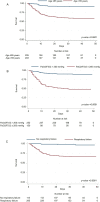Severity of respiratory failure at admission and in-hospital mortality in patients with COVID-19: a prospective observational multicentre study
- PMID: 33040020
- PMCID: PMC7549463
- DOI: 10.1136/bmjopen-2020-043651
Severity of respiratory failure at admission and in-hospital mortality in patients with COVID-19: a prospective observational multicentre study
Abstract
Objectives: COVID-19 causes lung parenchymal and endothelial damage that lead to hypoxic acute respiratory failure (hARF). The influence of hARF severity on patients' outcomes is still poorly understood.
Design: Observational, prospective, multicentre study.
Setting: Three academic hospitals in Milan (Italy) involving three respiratory high dependency units and three general wards.
Participants: Consecutive adult hospitalised patients with a virologically confirmed diagnosis of COVID-19. Patients aged <18 years or unable to provide informed consent were excluded.
Interventions: Anthropometrical, clinical characteristics and blood biomarkers were assessed within the first 24 hours from admission. hARF was graded as follows: severe (partial pressure of oxygen to fraction of inspired oxygen ratio (PaO2/FiO2) <100 mm Hg); moderate (PaO2/FiO2 101-200 mm Hg); mild (PaO2/FiO2 201-300 mm Hg) and normal (PaO2/FiO2 >300 mm Hg).
Primary and secondary outcome measures: The primary outcome was the assessment of clinical characteristics and in-hospital mortality based on the severity of respiratory failure. Secondary outcomes were intubation rate and application of continuous positive airway pressure during hospital stay.
Results: 412 patients were enrolled (280 males, 68%). Median (IQR) age was 66 (55-76) years with a PaO2/FiO2 at admission of 262 (140-343) mm Hg. 50.2% had a cardiovascular disease. Prevalence of mild, moderate and severe hARF was 24.4%, 21.9% and 15.5%, respectively. In-hospital mortality proportionally increased with increasing impairment of gas exchange (p<0.001). The only independent risk factors for mortality were age ≥65 years (HR 3.41; 95% CI 2.00 to 5.78, p<0.0001), PaO2/FiO2 ratio ≤200 mm Hg (HR 3.57; 95% CI 2.20 to 5.77, p<0.0001) and respiratory failure at admission (HR 3.58; 95% CI 1.05 to 12.18, p=0.04).
Conclusions: A moderate-to-severe impairment in PaO2/FiO2 was independently associated with a threefold increase in risk of in-hospital mortality. Severity of respiratory failure is useful to identify patients at higher risk of mortality.
Trial registration number: NCT04307459.
Keywords: COVID-19; respiratory infections; respiratory medicine (see thoracic medicine); respiratory physiology; virology.
© Author(s) (or their employer(s)) 2020. Re-use permitted under CC BY-NC. No commercial re-use. See rights and permissions. Published by BMJ.
Conflict of interest statement
Competing interests: None declared.
Figures


References
-
- World Health Organization COVID-19 situation report – 197, 2020. Available: https://www.who.int/docs/default-source/coronaviruse/situation-reports/2...
